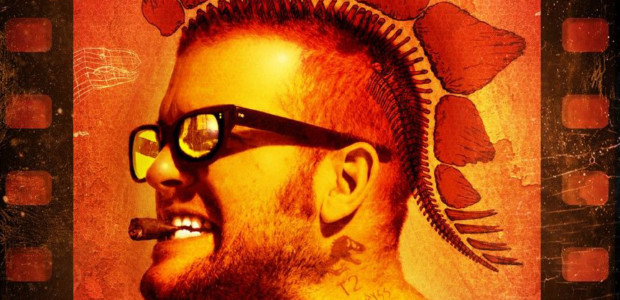
Steve ‘Spaz’ Williams may not be a household name, but the films that benefited from his particular brand of genius most certainly are. As a pioneer in the realm of computer animation, it was Williams who made the seemingly impossible, possible. Breathing unprecedented life into films like JURASSIC PARK, TERMINATOR 2: JUDGMENT DAY, and THE ABYSS, Williams revolutionized filmmaking forever by relentlessly pushing at the boundaries of possibility. So, why is Williams not more well-known? In the new documentary SPAZ, director Scott Leberecht seeks to remedy and explore that very question.
Recently making its World Premiere at this year’s SXSW Film Festival, SPAZ is an intimate look at one of cinema’s most unsung heroes. Introduced and largely narrated by Williams himself, the documentary charts his early life, career highlights, personal highs, and subsequent lows. Along with a wide array of both fresh and archived interviews from folks who knew Williams best, SPAZ contains a wealth of home video and rare behind-the-scenes footage. Not just a tribute to Williams and the movie magic he helped create, but an honest, critical look at Williams and the filmmaking industry itself.
In a familiar docu-profile style, SPAZ starts by recounting the early years of Williams’ life. Always fascinated with how things work, Williams’ aptitude for engineering and mathematics paired nicely with his affinity for art and creativity. Initially combining the two for more mundane, commercial applications that involved computer-generated simulations, things all changed when George Lucas’s famous Industrial Light & Magic studio reached out. Caught in a pickle with James Cameron’s latest project THE ABYSS, ILM needed talented computer graphic artists who could bring Cameron’s vision to life. And, in the late 1980s, that was a task much easier said than done.
After joining the team at ILM with fellow revolutionaries like Mark Dippé, the true potential of Williams became unleashed—for better or for worse. An incredibly potent personality, Williams’ larger-than-life presence, abrasive approach to authority, and ability to think outside the box was both his strength and his downfall. While his brilliance allowed him and his collaborators to blaze new trails in computer graphics technology with the T-1000 in T2, Williams quickly learned that brilliance only gets you so far. A magnetic, but difficult personality, Williams’ punk rock approach to filmmaking quickly began to ruffle the stodgier feathers that signed his checks.
As the film continues to follow Williams’ career, the gap between the old-school approach to filmmaking and the new school becomes evident. Soon after being hired to work on Steven Spielberg’s dinosaur epic JURASSIC PARK, Williams learned that the film would rely mostly on classic stop-motion animation with only a hint of CGI to be used for wider shots. Feeling cheated and knowing the technology could be used for more, Williams went directly against his superiors and created an early animation test of a T-Rex skeleton walking. Ambushing JURASSIC PARK producer Kathleen Kennedy with the footage, Williams blew Kennedy’s mind as well as the door for what was creatively possible. He also burned a lot of bridges in the process.
What follows in the next segment of the doc is an interesting peek into the politics and structural hierarchy of the filmmaking industry. Despite Williams and his fellow teammates doing nearly all of the hard work, the accolades and awards most often fell to others. For example, ILM won 14 Oscars for their visual effects work during Williams’ time there. Never once was he mentioned by name. Rarely properly recognized for his groundbreaking advancements in CGI technology, a natural bitterness set in with Williams. Never very good at navigating the political atmosphere that plagues the industry, things only began to spiral for Williams as he further refused to play nicely.
After leaving ILM and striking out on his own, Williams experienced a smidge of success through projects like SPAWN. However, the rapidly changing CGI-fueled landscape of cinema that he initially spearheaded quickly turned against him. Effecting both his professional and personal life, Williams turned to alcohol to soothe the spite. As the film catches up to Williams in the more present day, he is shown to be a man struggling to find both a purpose and place while learning to take responsibility for his behavior. Both a revolutionary and a reject, it’s a heartbreaking position for a person to be in. Never shying away from Williams’ penchant for drama, SPAZ beautifully presents the dichotomy of his position without rendering any judgment.
It’s often said that history is written by the victors. As such, SPAZ stands a valiant effort to rewrite this particular Hollywood story. Considering Leberecht’s past with visual effects himself, SPAZ could easily have veered into hero-worship territory. And, he wouldn’t really have been wrong to do so. An honest-to-god pioneer in the realm of filmmaking technology, Williams deserves much more praise and recognition than he has ever properly received. But then again, that’s not the full story here. Williams—by his own admission—is a difficult, flawed human being, who also happens to be a genius. Although SPAZ struggles sometimes to balance those two stories effectively, the conversation it has is undeniably fascinating. A long-overdue look at an unlikely Hollywood hero, SPAZ highlights the pitfalls and power of visionary foresight and rebellious thinking.
Tags: cgi, Documentaries, Film Festivals, George Lucas, James Cameron, Jurassic Park, Kathleen Kennedy, Mark Dippe, Scott Leberecht, Spawn, Spaz, Steve Williams, Steven Spielberg, SXSW, SXSW 2022, Terminator 2: Judgement Day, The Abyss, Visual Effects



No Comments